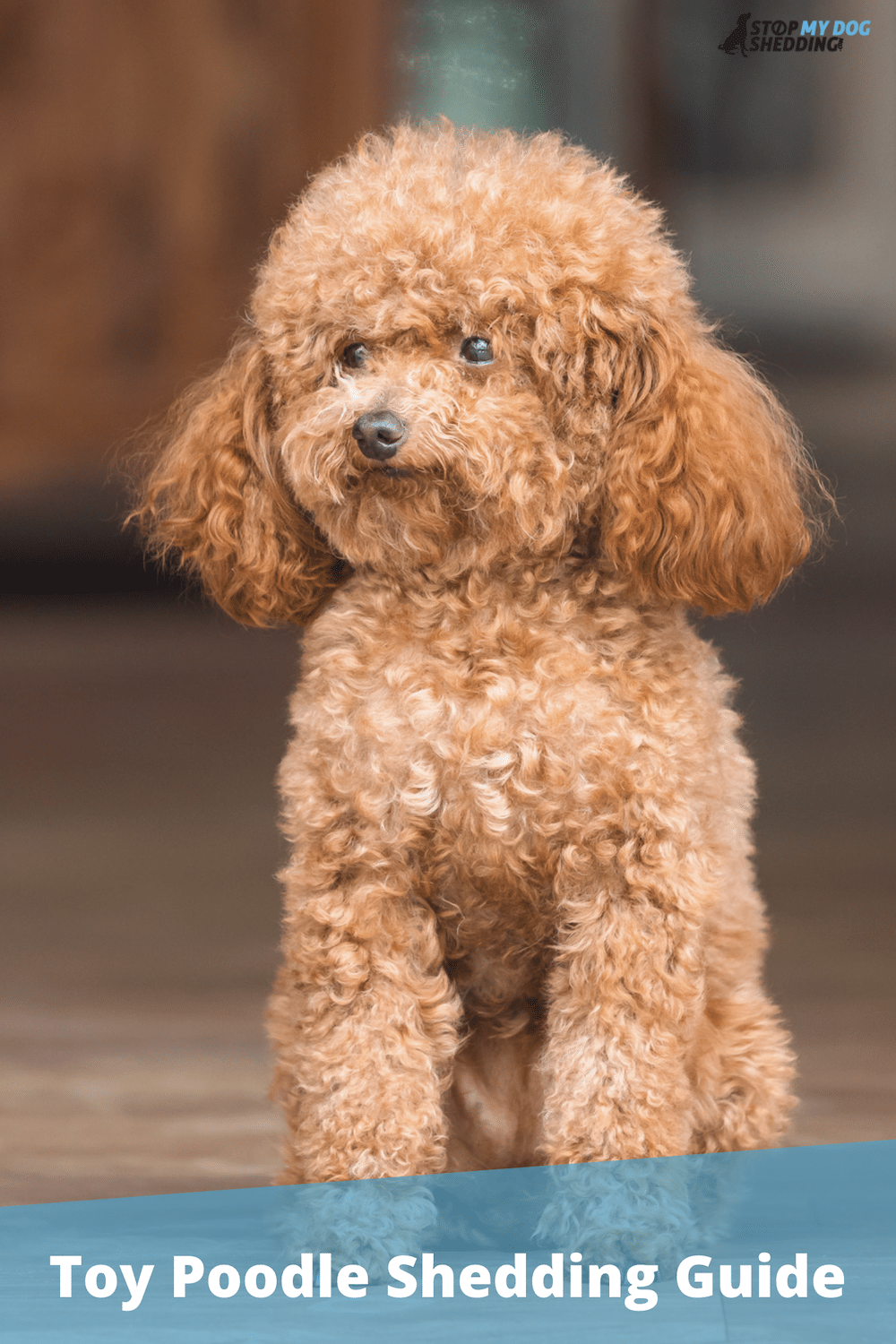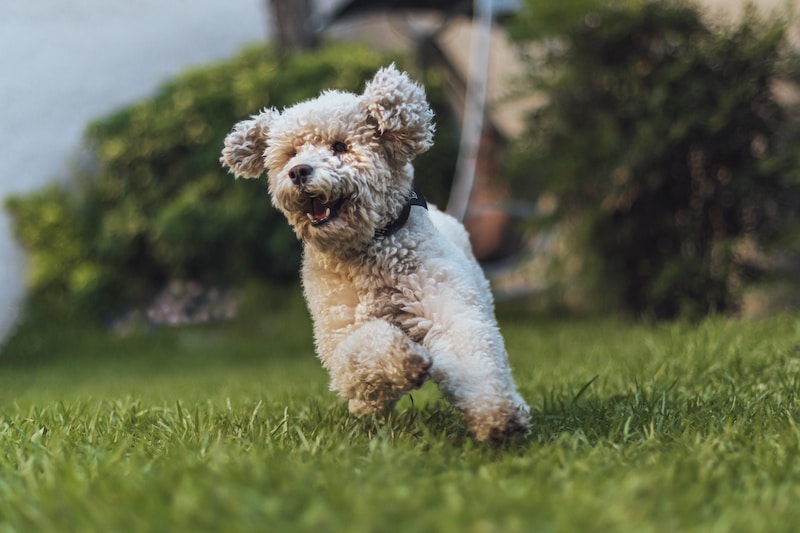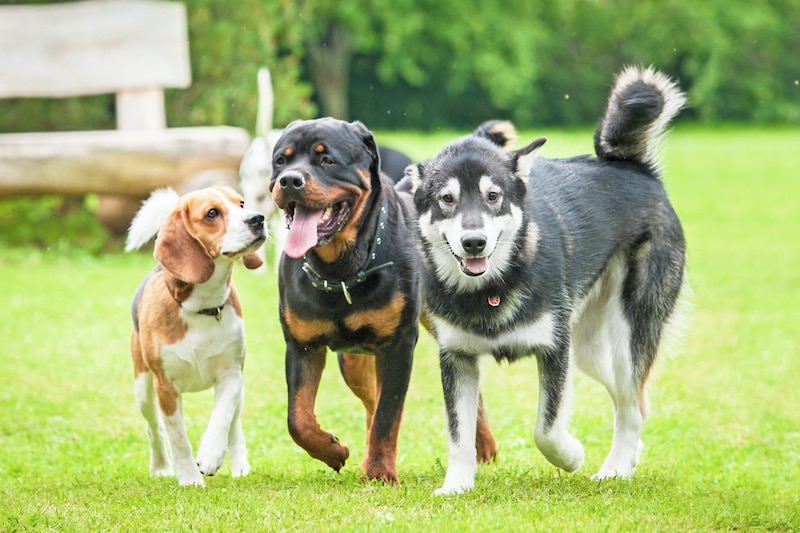There are three variations of Poodle; Standard, Miniature, and Toy. And The Toy Poodle is the smallest of the three. It weighs up to six pounds and stands a mighty 10 inches tall at most.
How much do they shed?
Like its full-sized counterpart, the Toy Poodle sheds minimally. This is due to four reasons: the Poodle’s single coat, the coat’s wiry texture, their extended hair growth cycle, and the Poodle’s size. Maintaining the Toy Poodle’s coat is where the bulk of your time and effort will go.
This article will be your guide to Toy Poodle shedding and grooming. I’ll show you what you need to know to help you decide if a Toy Poodle is your ideal canine companion.
Toy Poodle Shedding
Toy Poodles are among the lowest shedding breeds in dogdom.
This is true for all Poodle varieties, even the Standard Poodle. However, given the Toy Poodle is so tiny, the shedding is even less noticeable because, quite simply, they have less hair to lose. The less surface area a dog has, the less hair it can shed.
Another reason Toy Poodles shed so little is that they have a single coat.
Dogs are either single-coated or double-coated. For the canines with one coat, that’s all they have to keep them warm in the winter and cool in the summer. With no need for seasonal preparations, to so speak, a single-coated dog loses about the same amount of hair consistently.
You might see slightly more shedding during seasonal peaks, but not nearly as much as you would with a double-coated dog.
Those canines must prepare for winter by bulking up their coat, and shedding is part of this. Then, ahead of the summer, shedding occurs again to ready up for long, sunny, warm days.
Another reason they don’t shed much is due to the texture of their coat. While there are some exceptions (Lhasa Apso, I’m looking at you), for the most part, dogs with a wiry coat shed less than their smooth-furred counterparts.
When your Toy Poodle does lose fur, the density of its coat can hold onto the dead fur, so it doesn’t coat your carpeting.
Last but not least, another reason you won’t contend with much shedding from your Toy Poodle is because of its hair growth cycle.
All dog hair grows in four stages: anagen, catagen, telogen, and exogen. The anagen stage is when your dog’s fur actively grows. It rests during telogen and then releases during exogen.
Dogs with a fast hair growth cycle will shed more frequently than canines that take it slow when it comes to growing and releasing the hair. It just so happens the Toy Poodle is in the latter group.
Recommended: Go here to see our top-rated dog hair blow dryers
Grooming Your Toy Poodle
While you can put down the vacuum cleaner with a Toy Poodle in the house, you’ll need to pick up the slicker brush and the trimming scissors.
Grooming your Toy Poodle can be a daily occurrence depending on how you maintain its coat. The longer and poofier its fur, the more regularly you should brush your Toy Poodle.
Even if you don’t have to brush the dog daily, you should still do so several times per week, maybe every two to three days.
Brushing your Toy Poodle can encourage dead fur and skin to come out, and removing this from your dog’s coat can prevent a shedding mess all over the house. Also, collecting the dead skin or dander can help if you live with anyone with dander allergies.
It’s also best to brush your Toy Poodle to prevent knots and tangles in its fur. Due to the Poodle’s wiry coat, mats can frequently occur, especially if your Toy Poodle has areas of longer hair.
Once you’re done brushing, it’s time to trim the dog.
You have nearly countless trimming styles for your Poodle, whether yours is a posh show dog or a casual dog park regular. Here is an overview of some of the styles.
- English Saddler: The English Saddler haircut requires shaping the overgrowth around the head, face, and chest and upper midsection of your Toy Poodle. Since this area is intentionally fluffy, the rear is more closely trimmed. The tail is shaved except for a poofy show ring at the end. The front legs feature one ring of fur while the rear legs have two.
- Continental: The Continental cut is a lot like the English Saddler, but it has some key differences. The rear half of your dog is shaved except for a ring of fur at the back. Both legs feature one show ring nearer the paws.
- Puppy: The Puppy cut is a Poodle classic. You’d trim and shape the Toy Poodle’s fur around its head and body, then trim its face closely. The paws should be exposed, as should most of the tail except for a show ring around the tip.
- Lion: A Lion cut requires you to closely trim the Toy Poodle’s face and leave its head and ears fluffier. Its neck should be shaved, the chest trimmed but left fuzzy, and the rear half of the body shaved. Show rings should surround all four paws and the tip of the tail should be fluffy as well.
- Jacket and Pants: As the name alludes, a Jacket and Pants cut leaves all four legs of the Toy Poodle unshaved, just shaped and trimmed. The paws should be exposed, as should the whole rest of the body expect for the tip of the tail. The dog’s head and ears must be shaped, and its face trimmed.
- Bell Bottom: You can also try a Bell Bottom trim for your Toy Poodle. You’d closely trim its face and shape the fur around its head and ears. Its neck would be shaved but its upper body and front paws would remain fuzzy. Then you’d trim a strip around the belly and leave the back legs and most of the tail covered in fur. Shape the legs so the fur resembles bell bottom jeans.
Many of these Poodle cuts are reserved for show dogs or those who like having a Poodle as a status symbol. If you’re interested in one of the above cuts, but you don’t think you can pull it off yourself, you can always ask your groomer!
You should keep your Toy Poodle clean as well. Poodles don’t tend to smell stinky, which is great for your nostrils but can make it hard to gauge when to bathe them. I recommend doing so at least every two weeks and no more infrequently than once per month.
Recommended: Go here to see our top-rated dog hair blow dryers
Is a Toy Poodle Right For You?
Are you still trying to decide whether the Toy Poodle is the dog for you? Here is some more information that should help.
The Toy Poodle came about in the 20th century as a smaller version of the Miniature Poodle. It was bred for no reason other than companionability.
It took a lot of breeding trial and error to create a dog that didn’t have disfiguration, dwarfism, or behavioral issues. However, once Toy Poodle breeding standards were enforced, the resulting dogs were healthier and more appealing.
According to the American Kennel Club, the Toy Poodle is a confident, intelligent dog that is not overly difficult to train.
With their tiny size, a Toy Poodle would make a fantastic apartment dog. Keep in mind, though, that the Toy Poodle is a little bundle of energy.
It’s not the most athletic dog, but Toy Poodles like running around.
They also require mental stimulation. Play sessions at your local park or dog park should suffice for your new four-legged friend.
The Toy Poodle can befriend other dogs with socialization first. Always supervise play sessions with your canines, especially if you have bigger dogs in the house.
This tiny Poodle also enjoys the company of children, but again, socialization is a requirement first.
Toy Poodles have a bark that’s worse than their bite. However, they’re trainable enough that you can curtail excessive barking if it’s getting on your last nerve.
Recommended: Go here to see our top-rated dog hair blow dryers
Bottom Line
Toy Poodles are small Poodles that were first bred in the 20th century. They shed little, as do other Poodle sizes, but require extensive grooming to remove knots and mats and maintain their often complex Poodle cuts.
With their good-natured attitude and extraordinary intelligence, perhaps a Toy Poodle could be an excellent addition to your family!













Please note: By submitting a comment using the above comment form, you confirm that you agree with the storage and handling of your data by this site as detailed in our Privacy Policy.